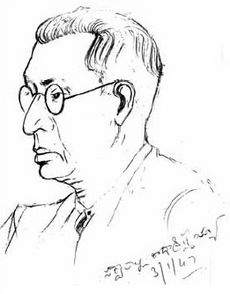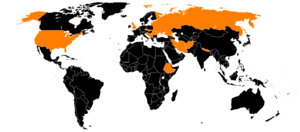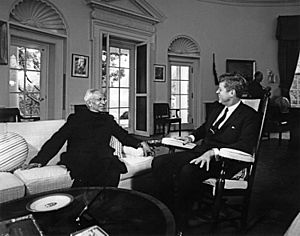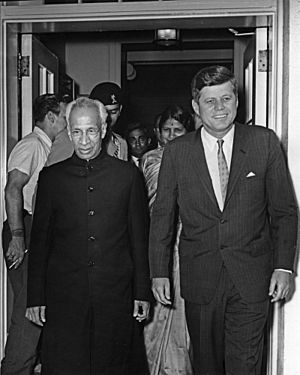Sarvepalli Radhakrishnan facts for kids
Quick facts for kids
Sarvepalli Radhakrishnan
|
|
|---|---|

Official Portrait, 1962
|
|
| 2nd President of India | |
| In office 13 May 1962 – 13 May 1967 |
|
| Prime Minister | |
| Vice President | Zakir Hussain |
| Preceded by | Rajendra Prasad |
| Succeeded by | Zakir Hussain |
| 1st Vice President of India | |
| In office 13 May 1952 – 12 May 1962 |
|
| President | Rajendra Prasad |
| Prime Minister | Jawaharlal Nehru |
| Preceded by | Position Established |
| Succeeded by | Zakir Hussain |
| 2nd Ambassador of India to Soviet Union | |
| In office 12 July 1949 – 12 May 1952 |
|
| Preceded by | Vijaya Lakshmi Pandit |
| Succeeded by | K. P. S. Menon |
| 4th Vice-Chancellor of Banaras Hindu University | |
| In office 1939–1948 |
|
| Preceded by | Pandit Madan Mohan Malaviya |
| Succeeded by | Amarnath Jha |
| Personal details | |
| Born |
Sarvepalli Radhakrishnayya
5 September 1888 Thiruttani, Madras Presidency, British India (present-day Tamil Nadu, India) |
| Died | 17 April 1975 (aged 86) Madras, Tamil Nadu, India (present-day Chennai) |
| Political party | Independent |
| Spouse | Sivakamu Radhakrishnan |
| Children | 6, 5 daughters and an only son Sarvepalli Gopal |
| Occupation | |
| Profession | |
| Awards |
|
| Known for | the Indian Philosophy: 2 volume set |
| Academic background | |
| Alma mater | |
| Academic work | |
| Discipline | |
| Institutions |
|
| Main interests | |
Sarvepalli Radhakrishnan (born September 5, 1888 – died April 17, 1975) was a famous Indian thinker and leader. He served as the second President of India from 1962 to 1967. Before that, he was the first Vice President of India from 1952 to 1962.
Radhakrishnan was also India's second Ambassador of India to the Soviet Union from 1949 to 1952. He held important positions in education, including Vice-Chancellor of Banaras Hindu University and Andhra University.
He was known as a top scholar in the 20th century, studying different religions and philosophies. He taught at major universities like the University of Calcutta and University of Oxford.
Radhakrishnan's ideas were based on Advaita Vedanta, a part of Hindu philosophy. He worked to explain Hinduism to the Western world and defended it against misunderstandings. He helped people in both India and the West better understand Hindu beliefs.
He received many high honors, including a knighthood in 1931 and the Bharat Ratna in 1954, which is India's highest civilian award. He also helped start Helpage India, an organization for older people. Radhakrishnan believed that "teachers should be the best minds in the country." Because of this, his birthday, September 5, is celebrated every year in India as Teachers' Day.
Contents
About Sarvepalli Radhakrishnan
Early Life and Family
Sarvepalli Radhakrishnan was born on September 5, 1888, in a Telugu-speaking family. His parents were Sarvepalli Veeraswami and Sithamma. He was born in Tiruttani, which was then part of Madras Presidency. His family came from a village called Sarvepalli in Andhra Pradesh.
He spent his early years in Thiruttani and Tirupati. His father worked for a local landlord. Radhakrishnan went to K. V. High School in Thiruttani. Later, he studied at the Hermansburg Evangelical Lutheran Mission School in Tirupati.
His Education Journey
Radhakrishnan earned scholarships throughout his school and college life. He went to Voorhees College in Vellore for his high school studies. At 16, he joined Madras Christian College, which was linked to the University of Madras. He finished his bachelor's degree in 1907 and his master's degree from the same college.
He ended up studying philosophy by chance. He didn't have much money, and a cousin gave him his old philosophy textbooks. This led him to choose philosophy as his main subject.
For his bachelor's thesis, he wrote about "The Ethics of the Vedanta and its Metaphysical Presuppositions." This paper aimed to show that the Vedanta system of philosophy did include ideas about ethics. His professors praised his work, and his thesis was published when he was just 20 years old.
Radhakrishnan said that criticism from some Christian teachers about Indian culture made him question his own beliefs. This led him to study Indian philosophy and Indian religions deeply. He spent his life defending Hinduism against what he called "uninformed Western criticism."
Marriage and Family Life
Radhakrishnan married Sivakamu, a distant cousin, when he was 16. Their marriage was arranged by their families, as was common at the time. They had five daughters: Padmavati, Rukmini, Sushila, Sundari, and Shakuntala. They also had one son, Sarvepalli Gopal, who became a well-known historian.
Many of Radhakrishnan's family members, including his grandchildren, have gone on to have successful careers. They work in areas like education, government, medicine, and business around the world. Sivakamu passed away on November 26, 1956, after they had been married for about 53 years.
His Academic Career

In April 1909, Radhakrishnan started working in the Philosophy Department at Madras Presidency College. In 1918, he became a Professor of Philosophy at the University of Mysore. During this time, he wrote many articles for important journals. He also finished his first book, The Philosophy of Rabindranath Tagore. He believed Tagore's ideas truly showed the "Indian spirit." His second book, The Reign of Religion in Contemporary Philosophy, came out in 1920.
In 1921, he became a philosophy professor at the University of Calcutta. He represented the University of Calcutta at major international conferences. One important event was when he was invited to give the Hibbert Lecture at Harris Manchester College, Oxford in 1929. These lectures were later published as a book called An Idealist View of Life.
In 1929, Radhakrishnan was asked to teach at Manchester College. This gave him the chance to lecture at the University of Oxford on different religions. For his contributions to education, he was knighted by King George V in 1931. He stopped using the title 'Sir' after India became independent in 1947.
He served as the vice-chancellor of Andhra University from 1931 to 1936. In 1936, he became a professor at the University of Oxford, focusing on Eastern Religion and Ethics. He was also nominated for the Nobel Prize in Literature several times. From 1939 to 1948, he was the Vice-Chancellor of Banaras Hindu University.
His Political Journey
Radhakrishnan started his political career later in life, after a very successful academic career. His international reputation was already strong. In 1931, he was chosen for the League of Nations' Committee for Intellectual Cooperation. This made him a recognized expert on Indian ideas in the Western world.
When India became independent in 1947, Radhakrishnan represented India at UNESCO. He then became India's Ambassador of India to the Soviet Union from 1949 to 1952. He was also part of the group that wrote India's constitution.
In 1952, Radhakrishnan was elected as the first Vice-President of India. Then, in 1962, he became the second President of India, serving until 1967. He was not part of any political party. His main goal was to promote and defend Hindu culture and ideas.
Teacher's Day in India
When Radhakrishnan became President of India, his students and friends wanted to celebrate his birthday, September 5. He suggested that instead of celebrating his birthday, they should celebrate it as Teacher's Day. He believed this would honor all teachers who shape the country's future.
Since 1962, September 5 has been celebrated as Teacher's Day across India.
Charity Work
Radhakrishnan also helped start the Krishnarpan Charity Trust. He worked with G. D. Birla and other social workers before India gained independence.

Radhakrishnan's Philosophy
Radhakrishnan aimed to connect Eastern and Western ways of thinking. He defended Hinduism against unfair criticism from the West. At the same time, he included ideas from Western philosophy and religion in his own thoughts.
Understanding Advaita Vedanta
Radhakrishnan was a key supporter of Neo-Vedanta. His main philosophical ideas were based on Advaita Vedanta. He explained this ancient tradition in a way that made sense for modern times. He believed that the world we experience is real and diverse, but it is all connected to the ultimate reality, called Brahman.
He also re-explained Shankara's idea of maya. For Radhakrishnan, maya doesn't mean the world is completely unreal. Instead, it means we sometimes misunderstand the world as being the ultimate reality itself, rather than seeing it as part of Brahman.
Intuition and Religious Experience
A very important part of Radhakrishnan's philosophy was "intuition," which he also called "religious experience." He saw this as a way of knowing things that doesn't rely on normal thinking. He believed intuition is self-proving and clear on its own. In his book An Idealist View of Life, he strongly argued for the importance of intuitive thought.
Radhakrishnan identified five types of experience:
- Cognitive Experience (like using your senses or reasoning)
- Psychic Experience
- Aesthetic Experience (about beauty)
- Ethical Experience (about right and wrong)
- Religious Experience
How He Classified Religions
Radhakrishnan believed that religious ideas and beliefs are ways of trying to explain "religious experience." He ranked different religions based on how well they understood this experience. He placed Advaita Vedanta at the highest level:
- Those who worship the Absolute (the highest reality)
- Those who worship a personal God
- Those who worship divine forms like Rama, Krishna, or Buddha
- Those who worship ancestors, deities, and wise people
- Those who worship small forces and spirits
Radhakrishnan saw Hinduism as a logical religion based on facts, understood through intuition. He said that "if philosophy of religion is to become scientific, it must become empirical and found itself on religious experience."
He explained that Hinduism encourages people to improve their understanding of God step by step. He believed that the wisest people find God within themselves, not just in images or specific places.
Awards and Honors
Civilian Awards
From India
 Recipient of the Bharat Ratna (1954)
Recipient of the Bharat Ratna (1954) Knight Bachelor (1931), he stopped using the title 'Sir' after India became independent in 1947.
Knight Bachelor (1931), he stopped using the title 'Sir' after India became independent in 1947.
From Other Countries
 Recipient of the Pour le Mérite for Sciences and Arts (Germany, 1954)
Recipient of the Pour le Mérite for Sciences and Arts (Germany, 1954) Sash First Class of the Order of the Aztec Eagle (Mexico, 1954)
Sash First Class of the Order of the Aztec Eagle (Mexico, 1954) Honorary member of the Order of Merit (United Kingdom, 1963)
Honorary member of the Order of Merit (United Kingdom, 1963)
Other Achievements
- A painting of Radhakrishnan is displayed in the Chamber of the Rajya Sabha (India's upper house of Parliament).
- From 1933 to 1937, he was nominated five times for the Nobel Prize in Literature.
- In 1938, he was elected a Fellow of the British Academy.
- In 1961, he received the Peace Prize of the German Book Trade.
- In 1962, Teacher's Day was started in India on his birthday, September 5. This honors his belief that "teachers should be the best minds in the country."
- In 1968, he received the Sahitya Akademi fellowship, the highest honor given to a writer by the Sahitya Akademi. He was the first person to get this award.
- In 1975, he won the Templeton Prize for promoting peace and a universal understanding of God. He gave all the prize money to Oxford University.
- In 1989, Oxford University started the Radhakrishnan Scholarships in his memory. These were later renamed the "Radhakrishnan Chevening Scholarships."
- He was nominated 16 times for the Nobel Prize in Literature and 11 times for the Nobel Peace Prize.
Commemorative stamps released by India Post (by year) -
Famous Quotes
- "It is not God that is worshipped but the authority that claims to speak in His name. Sin becomes disobedience to authority not violation of integrity."
- "Reading a book gives us the habit of solitary reflection and true enjoyment."
- "When we think we know, we cease to learn."
- "There is nothing wonderful in my saying that Jainism was in existence long before the Vedas were composed."
- "A life of joy and happiness is possible only on the basis of knowledge."
Images for kids
See also
 In Spanish: Sarvepalli Radhakrishnan para niños
In Spanish: Sarvepalli Radhakrishnan para niños
- List of Indian writers
- Indian philosophy
- Vedanta Society
- Sarvepalli Gopal










